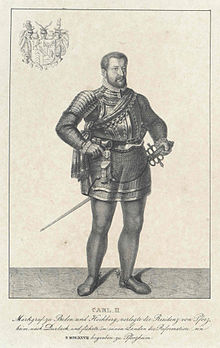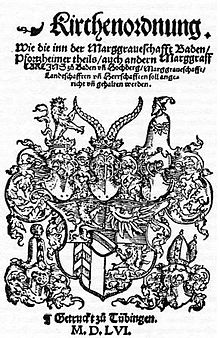Charles II, Margrave of Baden-Durlach
Charles II, Margrave of Baden-Durlach | |
|---|---|
 Charles II, Margrave of Baden-Durlach | |
| Born | 24 July 1529 Pforzheim |
| Died | 23 March 1577 (aged 47) Durlach |
| Noble family | House of Zähringen |
| Spouse(s) | |
| Issue Detail | |
| Father | Ernest, Margrave of Baden-Durlach |
| Mother | Ursula of Rosenfeld |
Charles II, Margrave of Baden-Durlach (born 24 July 1529 in
Life
Charles was the son of Margrave Ernest of Baden-Durlach and his second wife Ursula of Rosenfeld. Since the marriage between Ernest and Ursula was morganatic, Charles's ability to succeed was disputed. Nevertheless, he started ruling Upper Baden in his father's name in September 1552. His half-brother, older by 12 years, Bernard IV, died on 20 January 1553 and his father died two weeks later, on 6 February. Charles then inherited the entire country,[1] which was called Baden-Pforzheim at the time. He moved the capital to Durlach, thereby changing the name of his country to Baden-Durlach.
The introduction of the Reformation in 1556

After the Peace of Passau (1552) a number of secular rulers in the south west of Germany introduced the Reformation. Margrave Ernest of Baden-Durlach had plans to have had follow suit, but still faced a potential conflict with Archduke Ferdinand, the ruler of the Roman Catholic Further Austria, the who still claimed parts of Upper Baden.[2]
Margrave Charles II – like his cousin, Margrave Philibert of Baden-Baden – supported the
The preparation of the Reformation and the drafting of church order was entrusted to a Commission chaired by Martin Achtsynit, the Chancellor of the Margraviate of Baden (Pforzheimer part). Members of the Commission were the
Frequent visitations should ensure that only Lutheran pastors were active and the church order was complied with. Many Catholic priests were expelled. Ferdinand of Austria formally denied Charles the right to introduce the Reformation in his possessions in Breisgau. The people gave Charles the nickname the Pious, referring to the zeal he developed while introducing the Reformation.
As a result, the Ernestine part of Baden turned
In 1561, the Margrave avowed to the unchanged
The prelate controversy
The Reformation had the effect that the territory of the Margrave of Baden-Durlach only Lutheran pastors were permitted. The
The relocation of the residence to Durlach in 1565
The Margrave moved the residence from Liebeneck Castle in Pforzheim to Durlach in 1565. This was allegedly triggered by a dispute with the citizens of Pforzheim, who refused to act as drivers in a drive hunt organized by the Margrave. The literature points out that other, more rational, reasons may have existed; in particular, Durlach was more centrally located within Lower Baden.[8]
For this move, the Karlsburg, an existing hunting lodge in Durlach, was expanded into a castle. Charles oversaw the expansion himself and paid the workers personally, using a shoulder bag full of money he brought with him. The affectionate nickname Charles with the Bag refers to this practice.
The city of Durlach was also renovated. A garden was added to the castle and several gates were added to the city wall. In 1571, a
Marriages and issue
Charles II first married on 10 March 1551 with
- Marie (born: 3 January 1553; died: 11 November 1561)
- Albert (born: 12 June 1555; died: 5 May 1574)
Charles II then married on 1 August 1558 Countess Palatine
- Dorothea Ursula (born: 20 June 1559; died: 19 May 1583)
- married on 7 November 1575 Louis III of Württemberg (born: 1 January 1554; died: 18 August 1593)
- Ernest Frederick (born: 17 October 1560; died: 14 April 1604)
- married on 21 December 1585 Anna of East Frisia (born: 26 May 1562; died: 21 April 1621), the daughter of Count Edzard II of East Frisia
- James III (born: 26 May 1562; died: 17 August 1590)
- married on 6 September 1584 Elisabeth of Pallandt-Culemborg (born c. 1567; died: 8 May 1620), the daughter of Count Floris I of Pallandt-Culemborg (1537–1598); reigning Margrave
- Anna Marie (born: 4 August 1565; died: 8 October 1573)
- Elizabeth (born: 27 September 1570; died: 6 October 1611)
- George Frederick born: 30 January 1573; died: 24 September 1638); reigning Margrave
After Charles II's death, Baden-Durlach was split-up between his three sons: Baden-Durlach-Hachberg went to James III; Baden-Durlach-Sausenberg went to George Frederick; the remaining Baden-Durlach went to Ernst Frederick who became
Ancestors
| Ancestors of Charles II, Margrave of Baden-Durlach | |||||||||||||||||||||||||||||||||||||||||||||||||||||||||||||||||||||||||||||||||||||||||||||||||||||||||||||||||||||||||||||||||||||||||||||||||||||||||||||||||||||||||||||||||||||||||||||||||||||||||||||||||||||||||||||||||||||||||||||||||||||||||||||||||||||||||||||||||||||||||
|---|---|---|---|---|---|---|---|---|---|---|---|---|---|---|---|---|---|---|---|---|---|---|---|---|---|---|---|---|---|---|---|---|---|---|---|---|---|---|---|---|---|---|---|---|---|---|---|---|---|---|---|---|---|---|---|---|---|---|---|---|---|---|---|---|---|---|---|---|---|---|---|---|---|---|---|---|---|---|---|---|---|---|---|---|---|---|---|---|---|---|---|---|---|---|---|---|---|---|---|---|---|---|---|---|---|---|---|---|---|---|---|---|---|---|---|---|---|---|---|---|---|---|---|---|---|---|---|---|---|---|---|---|---|---|---|---|---|---|---|---|---|---|---|---|---|---|---|---|---|---|---|---|---|---|---|---|---|---|---|---|---|---|---|---|---|---|---|---|---|---|---|---|---|---|---|---|---|---|---|---|---|---|---|---|---|---|---|---|---|---|---|---|---|---|---|---|---|---|---|---|---|---|---|---|---|---|---|---|---|---|---|---|---|---|---|---|---|---|---|---|---|---|---|---|---|---|---|---|---|---|---|---|---|---|---|---|---|---|---|---|---|---|---|---|---|---|---|---|---|---|---|---|---|---|---|---|---|---|---|---|---|---|---|---|---|---|---|---|---|---|---|---|---|---|---|---|---|---|---|---|---|
| |||||||||||||||||||||||||||||||||||||||||||||||||||||||||||||||||||||||||||||||||||||||||||||||||||||||||||||||||||||||||||||||||||||||||||||||||||||||||||||||||||||||||||||||||||||||||||||||||||||||||||||||||||||||||||||||||||||||||||||||||||||||||||||||||||||||||||||||||||||||||
See also
- List of rulers of Baden
References and sources
- Hans Jürgen Rieckenberg (1977), "Karl II.", Neue Deutsche Biographie (in German), vol. 11, Berlin: Duncker & Humblot, pp. 220–221
- Arthur Kleinschmidt (1882), "Karl II., Markgraf von Baden-Durlach", Allgemeine Deutsche Biographie (in German), vol. 15, Leipzig: Duncker & Humblot, pp. 233–237
- Karl Friedrich Vierordt: Geschichte der evangelischen Kirche in dem Großherzogthum Baden, vol. 1, Karlsruhe, 1847, pp. 420–441 at Google Books
- Joseph Elble: Die Einführung der Reformation im Markgräflerland und in Hochberg. 1556–1561, in: Freiburger Diözesan-Archiv, vol. 42 (1914), pp. 1–110
- Johann Pflüger: Geschichte der Stadt Pforzheim, Pforzheim, 1989 at Google Books
- Ernst Walter Zeeden: Kleine Reformationsgeschichte von Baden-Durlach und Kurpfalz, Karlsruhe, 1956
- Rudolf Burger: Die Reformation im Markgräflerland, Weil am Rhein, 1984
